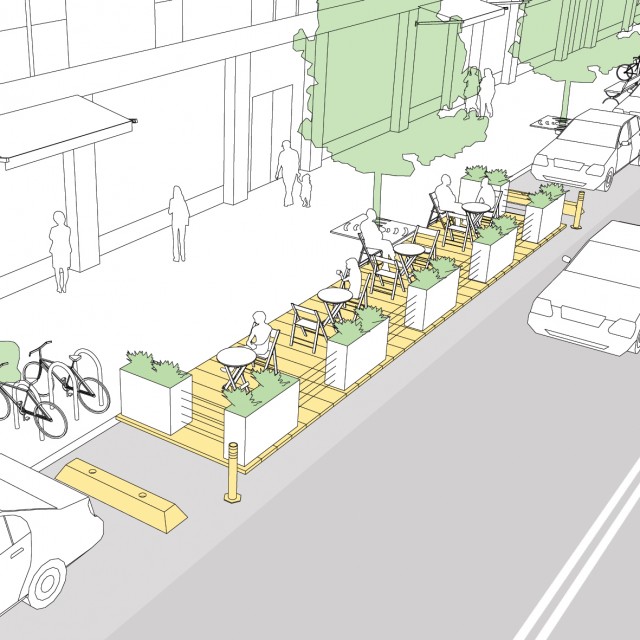Many REALTOR® Associations are looking for placemaking projects to do in their community but are at a loss for what to do. For them, I recommend a parklet because every community has a parking spot or two which could be transformed into a people spot.
There are several other blog posts on parklets to give you an overview, get you prepared for Park(ing) Day (temporary parklets) and see how parklets are done in other cities. Take a look:
- Parklets: Spots for People, not Cars
- Another Push for Parklets
- Get Ready for PARK(ing) Day
- Transform Your Street, One Parking Space at a Time
- Bringing Parklets to Chicago
AARP also thinks parklets are a good idea and has come up with some basic tips on how to get started in building a parklet in your community.
Step 1
Determine your community's parklet rules as many now have an application process, often involving fees and requirements for detailed plans and drawings. The local department of transportation, public works or a similar office is typically the agency to contact.
Parklets are typically installed where narrow or congested sidewalks prevent the placement of traditional sidewalk cafés, or where local property owners or residents see a need to expand the seating capacity and public space on a given street.

Where
A typical on-street parallel parking spot measures about 9 feet by 18 feet. A parklet might take up one or two of these spots. If the parking spot runs perpendicular or diagonal to the street and sidewalk, three spaces may be needed. The chosen location should provide or allow for a buffer between traffic and the parklet. Other characteristics of good locations include streets that already have some pedestrian and bicycling traffic and where the surface is flat or has only a minimal slope. Of course a parklet can’t block fire hydrants, driveways, bus stops, etc.

When
Parklets can remain in place for an entire season, several weeks or days, or even just a few hours.

Why and For Whom
Parklets are free public spaces that are available and accessible to all users.
Stakeholders
Parklets are typically administered through partnerships with adjacent businesses and/or surrounding residents. Partners maintain the parklet, keeping it free of trash and debris. They also program the activities, if there are any. Where no local partners are present, a parklet might be installed and managed by the municipality, just as it would a traditional park or public space.
Costs
The price of creating a parklet can vary greatly depending on the materials and design. Designer Melissa Miklus of Alta Planning + Design and Baltimore-area fitness instructor Arielle Gordon each contributed their expertise. AARP's sample parklet was built from donated and discarded items, and it was assembled by volunteer labor. We used wooden pallets and reclaimed wood to create exercise stations, planters and our library. (Low-cost or free pallets can be found online or at local stores that receive large deliveries.)
Materials
The duration and location of the parket will influence the type of materials that need to be used. Depending on a community's requirements, if any, the floor of the parklet can be a raised platform or simply the street, either with bare pavement or covered with strips of sod or even indoor/outdoor carpeting. Aside from the main features (benches, tables, etc.), a parklet should have vertical elements that are clearly visible to nearby traffic and a border or enclosure that defines the space. (A tip: Parklet items should be heavy enough to make theft impossible or difficult.)
Maintenance
Like any public space, a parklet may require trash pickups, landscaping and repairs.
Benefits
Aside from providing places for people to enjoy and gather, the presence of on-street parklets increases foot traffic for adjacent businesses. According to the National Association of City Transportation Officials (NACTO), after a parklet installation the Green Line Café in Philadelphia saw a 20 percent increase in revenue and the Mojo Café in San Francisco experienced a 30 percent increase.

Learn More
The following organizations and resources can provide more information about parklets and other community enhancement features.
















